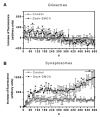Reactive Astrocytosis in a Mouse Model of Chronic Polyamine Catabolism Activation
- PMID: 34572487
- PMCID: PMC8467798
- DOI: 10.3390/biom11091274
Reactive Astrocytosis in a Mouse Model of Chronic Polyamine Catabolism Activation
Abstract
Background: In the brain, polyamines are mainly synthesized in neurons, but preferentially accumulated in astrocytes, and are proposed to be involved in neurodegenerative/neuroinflammatory disorders and neuron injury. A transgenic mouse overexpressing spermine oxidase (SMOX, which specifically oxidizes spermine) in the neocortex neurons (Dach-SMOX mouse) was proved to be a model of increased susceptibility to excitotoxic injury.
Methods: To investigate possible alterations in synapse functioning in Dach-SMOX mouse, both cerebrocortical nerve terminals (synaptosomes) and astrocytic processes (gliosomes) were analysed by assessing polyamine levels, ezrin and vimentin content, glutamate AMPA receptor activation, calcium influx, and catalase activity.
Results: The main findings are as follows: (i) the presence of functional calcium-permeable AMPA receptors in synaptosomes from both control and Dach-SMOX mice, and in gliosomes from Dach-SMOX mice only; (ii) reduced content of spermine in gliosomes from Dach-SMOX mice; and (iii) down-regulation and up-regulation of catalase activity in synaptosomes and gliosomes, respectively, from Dach-SMOX mice.
Conclusions: Chronic activation of SMOX in neurons leads to major changes in the astrocyte processes including reduced spermine levels, increased calcium influx through calcium-permeable AMPA receptors, and stimulation of catalase activity. Astrocytosis and the astrocyte process alterations, depending on chronic activation of polyamine catabolism, result in synapse dysregulation and neuronal suffering.
Keywords: astrocyte processes; excitotoxicity; nerve terminals; oxidative stress; polyamines; spermine oxidase (SMOX).
Conflict of interest statement
The authors declare no conflict of interest.
Figures





Similar articles
-
Astrocyte-Dependent Vulnerability to Excitotoxicity in Spermine Oxidase-Overexpressing Mouse.Neuromolecular Med. 2016 Mar;18(1):50-68. doi: 10.1007/s12017-015-8377-3. Epub 2015 Nov 3. Neuromolecular Med. 2016. PMID: 26530396
-
Glutamate Excitotoxicity Linked to Spermine Oxidase Overexpression.Mol Neurobiol. 2018 Sep;55(9):7259-7270. doi: 10.1007/s12035-017-0864-0. Epub 2018 Feb 3. Mol Neurobiol. 2018. PMID: 29397558
-
Transgenic Mouse Overexpressing Spermine Oxidase in Cerebrocortical Neurons: Astrocyte Dysfunction and Susceptibility to Epileptic Seizures.Biomolecules. 2022 Jan 25;12(2):204. doi: 10.3390/biom12020204. Biomolecules. 2022. PMID: 35204705 Free PMC article. Review.
-
The Involvement of Polyamines Catabolism in the Crosstalk between Neurons and Astrocytes in Neurodegeneration.Biomedicines. 2022 Jul 21;10(7):1756. doi: 10.3390/biomedicines10071756. Biomedicines. 2022. PMID: 35885061 Free PMC article. Review.
-
Epileptic seizures and oxidative stress in a mouse model over-expressing spermine oxidase.Amino Acids. 2020 Feb;52(2):129-139. doi: 10.1007/s00726-019-02749-8. Epub 2019 Jun 13. Amino Acids. 2020. PMID: 31197571
Cited by
-
Calcium Signaling in Astrocytes and Its Role in the Central Nervous System Injury.Mol Neurobiol. 2025 May 26. doi: 10.1007/s12035-025-05055-5. Online ahead of print. Mol Neurobiol. 2025. PMID: 40419752 Review.
-
Astrocytes in Neurodegeneration: Inspiration From Genetics.Front Neurosci. 2022 Jun 24;16:882316. doi: 10.3389/fnins.2022.882316. eCollection 2022. Front Neurosci. 2022. PMID: 35812232 Free PMC article. Review.
-
The Key Role of Astrocytes in Amyotrophic Lateral Sclerosis and Their Commitment to Glutamate Excitotoxicity.Int J Mol Sci. 2023 Oct 21;24(20):15430. doi: 10.3390/ijms242015430. Int J Mol Sci. 2023. PMID: 37895110 Free PMC article. Review.
-
Identification and Characterization of Novel Small-Molecule SMOX Inhibitors.Med Sci (Basel). 2022 Aug 30;10(3):47. doi: 10.3390/medsci10030047. Med Sci (Basel). 2022. PMID: 36135832 Free PMC article.
-
The Gut-Brain Axis as a Therapeutic Target in Multiple Sclerosis.Cells. 2023 Jul 17;12(14):1872. doi: 10.3390/cells12141872. Cells. 2023. PMID: 37508537 Free PMC article. Review.
References
-
- Cervelli M., Fratini E., Amendola R., Bianchi M., Signori E., Ferraro E., Lisi A., Federico R., Marcocci L., Mariottini P. Increased Spermine Oxidase (SMO) Activity as a Novel Differentiation Marker of Myogenic C2C12 Cells. Int. J. Biochem. Cell Biol. 2009;41:934–944. doi: 10.1016/j.biocel.2008.09.009. - DOI - PubMed
Publication types
MeSH terms
Substances
LinkOut - more resources
Full Text Sources
Molecular Biology Databases
Miscellaneous

